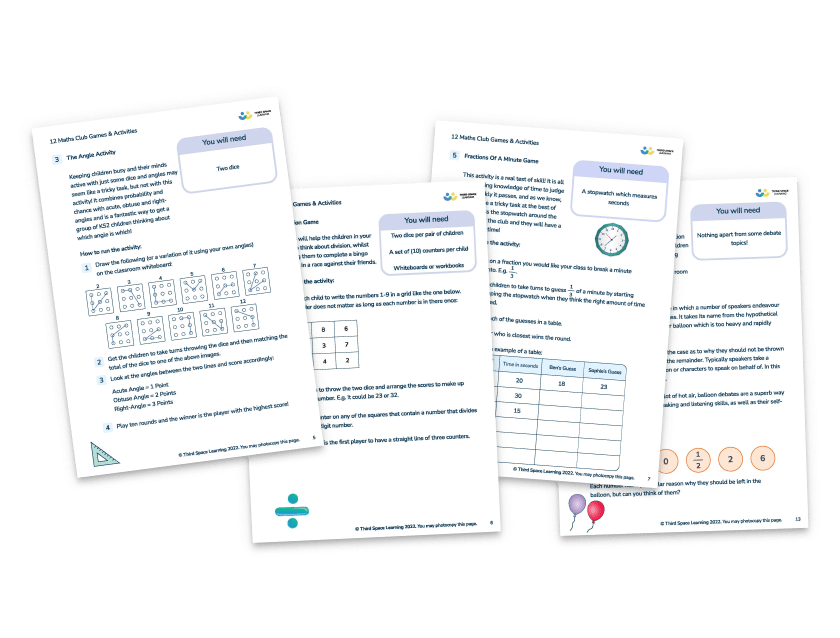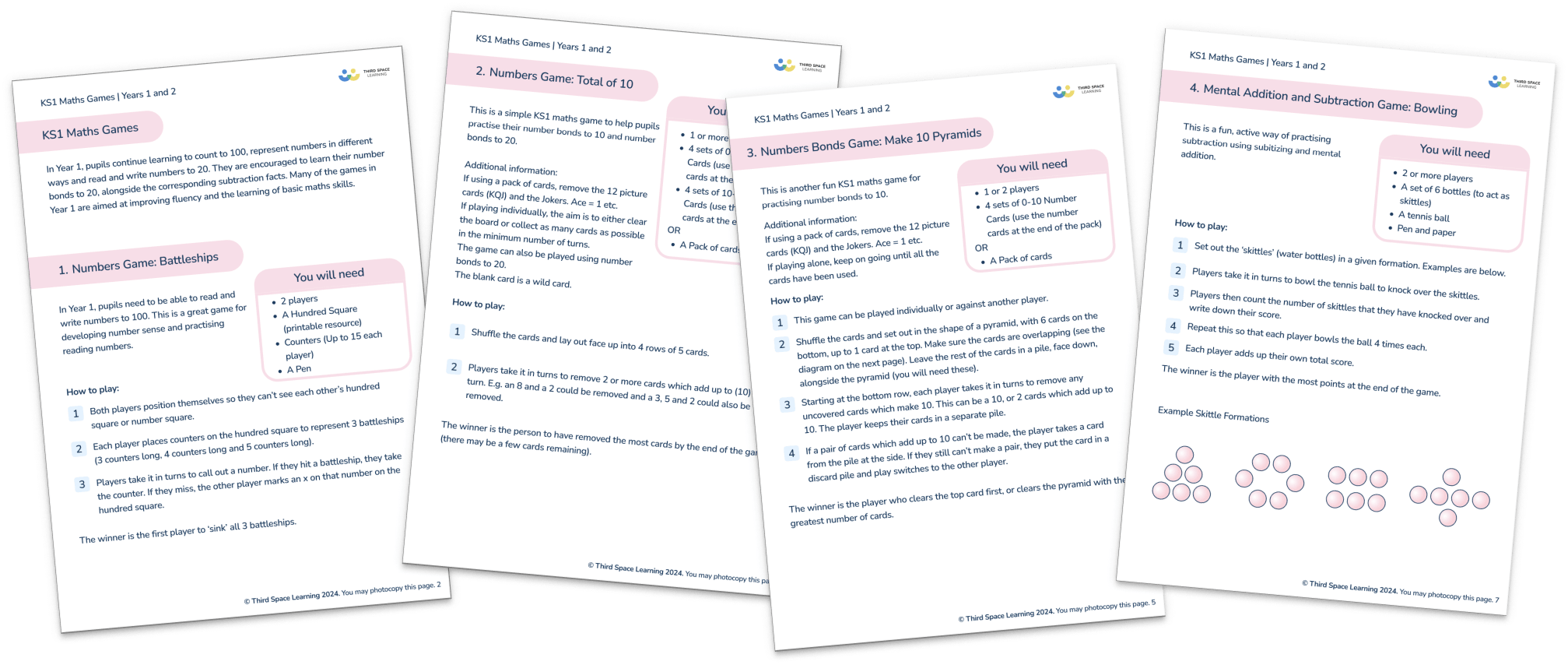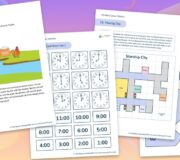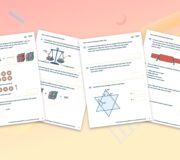24 Fun KS1 Maths Games And Activities To Play At Home And School
We’ve brought together 24 of the best KS1 maths games to give teachers and parents some new ideas on how to improve pupils’ numeracy in and out of school.
At KS1, maths games, such as multiplication games, are a great way to motivate, engage and inspire children while still having fun. Children in key stage 1 are ready to start practising and developing a whole range of maths concepts and skills, particularly their fluency and strategic thinking.
Inevitably, some people consider these sorts of educational games to be an ‘end of term’ or ‘filler’ activity in the classroom, when they are actually an excellent way of helping children learn basic number facts and explore fundamental number concepts at any time.
When searching for fun maths games on the internet, a large number of search results are often for digital online games. While these too have their place, they aren’t always practical to manage with a class of 30.
In this blog, I will be introducing a range of non-digital games that are interactive in a different sense. While all these maths games are all suitable for primary school children in key stage 1, you’ll find, as with many maths activities, they aren’t restricted to one year group and can be easily adapted to suit children of different ages. They can also be adapted for use in small groups and learning interventions, as well as whole class environments.
Don’t forget to download the printable resources required for a few of the KS1 maths games.
KS1 Maths games printables
All the printable resources you'll need to complete these games
Download Free Now!- Maths games for year 1
- Maths games for year 2
- 9. Place value two digit number game: in the bucket
- 10. Addition maths game: skunk
- 11. Addition maths game: make 20
- 12. Maths fluency game: maths fact top it
- 13. Addition and subtraction game: guess my number
- 14. Shapes game: what shape am I?
- 15. Maths dice game: ten sided dice rounding game
- 16. Maths fractions game: snap
- Mental maths games KS1
- Problem solving games KS1
Maths games for year 1
In year 1, children continue learning to count to 100, represent numbers in different ways and read and write numbers to 20. They are encouraged to learn their number bonds to 20, alongside the corresponding subtraction facts. Many of the games in year 1 are aimed at improving fluency and the learning of basic maths skills.
1. Number game: battleships
In year 1, children need to be able to read and write numbers to 100. This is a great game for developing number sense and practising reading numbers.
What you will need to play:
- 2 players
- A hundred square (see downloadable resource pack)
- Counters
- A pen
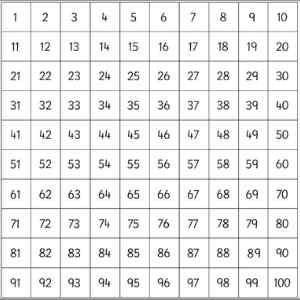
How to play:
- Both players position themselves so they can’t see each other’s hundred square or number square.
- Each player places counters on the hundred square to represent 3 battleships (3 counters long, 4 counters long and 5 counters long).
- Players take it in turns to call out a number. If they hit a battleship, they take the counter. If they miss, the other player marks an x on that number on the hundred square.
- The winner is the first player to ‘sink’ all 3 battleships.

Meet Skye, the voice-based AI tutor making maths success possible for every student.
Built by teachers and maths experts, Skye uses the same pedagogy, curriculum and lesson structure as our traditional tutoring.
But, with more flexibility and a lower cost, schools can scale online maths tutoring to support every student who needs it.
Watch Skye in action2. Number game: total of 10
This is a simple KS1 maths game to help children practise their number bonds to 10 and number bonds to 20
What you will need to play:
- 1 or more players
- A pack of cards with the picture cards removed. Ace is worth 1.
How to play:
- Shuffle the cards and lay out face up into 4 rows of 5 cards.
- The aim of the game is to remove all the cards from the table in sets of 2 or more cards which add up to 10. E.g. an 8 and a 2 could be removed and a 3, 5 and 2 could also be removed.
- The game can be played individually, with players trying to clear as much of the table as they can.
- If played with other players, take it in turns to remove cards. The winner is the person to have removed the most cards by the end of the game.
- The game can also be played using number bonds to 20, by finding cards which add up to 20.
3. Number bonds game: make 10 pyramids
This is another fun KS1 maths game for practising number bonds to 10.
What you will need to play:
- 1 or 2 players.
- A pack of cards (with picture cards removed) Ace is worth 1
How to play:
- This game can be played individually or against another player.
- Shuffle the cards and set out in the shape of a pyramid, with 6 cards on the bottom, up to 1 card at the top. Make sure the cards are overlapping, as in the picture below.
- The aim of the game is to remove all the cards which make 10. This can be 10 on it’s own, or 2 cards which add up to 10.
- Only cards which aren’t covered by another card can be removed, so players have to start with the bottom row.
- If a pair of cards which add up to 10 can’t be made, the player takes a card from the pile at the side.
- If they still can’t make a pair, they put the card in the discard pile and take another card from the face down pile.
- If playing with another player, each person takes it in turns to try and make 10. If playing alone, keep on going until all the cards have been used.
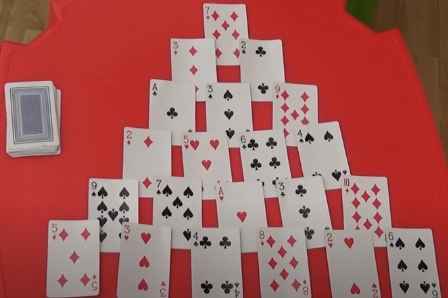
4. Mental addition and subtraction game: bowling
This is a fun, active way of practising subtraction using subitizing and mental addition.
What you will need to play:
- 2 or more players
- A set of 6 bottles (to act as skittles) with circle stickers set out in patterns.
- A tennis ball
- Paper and pen
How to play:
- Set out the ‘skittles’ (water bottles)
- Children take it in turns to bowl their ball.
- They check the skittles that have been knocked over and add together the total on each skittle.
- If they are correct, they get to keep the score from the fallen skittles. This is recorded.
- The winner is the player with the most points at the end of the game.
5. Place value game: sorting and matching
In year 1, children need to be able to identify and represent numbers using objects and pictorial representations. This sorting and matching activity is a good way to practise this skill.
What you will need to play:
- 1 player
- Multi-link cubes
- Dienes base 10
- Using the multi-link cubes, children make stacks of varying sizes, from 1 to 10 cubes in length.
- Ask children to order the stacks of cubes from smallest to largest.
- Once this is complete, ask the child to turn away, mix up the stacks and add some Dienes base 10.
- Children need to match up the Dienes pieces with the corresponding stack of cubes.
- Children working at a different level can be extended further by sorting them into 2 groups – odd and even numbers.
- 2 players
- 2 dice
- Paper and pen
How to play:
- Both players throw 2 dice and add the 2 numbers together. The player with the highest answer wins the round
- The winner is the first player to reach 10 points.
- The game can be adapted by using 10 sided dice, or by adding a third dice.
7. Addition and subtraction game: grab
In this KS1 maths game, children use concrete resources to practise their addition and subtraction skills. They also get to practise writing out number sentences.
What you will need to play:
- 1 or more players
- 2 bowls filled with cubes or other small objects
- Paper and pen.
How to play:
- This game can be played individually or as a speed game against another player.
- Grab a handful of objects from each bowl, count how many in each pile and write out an addition or subtraction sentence (remind children that the largest number needs to go first if they are practising subtraction).
- If playing against another player. Both players take a handful, then race each other to write out the addition/subtraction number sentence.
8. Addition game: ‘pig’
This is a simple KS1 maths game for practising mental addition skills.
What you will need to play:
- 2 players
- 2 dice
- Paper and pen
How to play:
- The first player roles the dice and if the dice lands on a 2, 3, 4, 5 or 6 , they can either record the number and let the other player have a turn, or throw again to try and increase the total.
- The aim of the game is to be the first player to reach 100, by throwing a dice and adding to the total each time.
- If a 1 is thrown at any stage, the player loses all the points for that round and score zero.
- The game can also be played with 2 dice, with players adding the totals of both dice each time. If at any stage, they thow two ones, then not only do they lose any points from that round, but they lose all the points gained in the game so far.
Maths games for year 2
In year 2, children are expected to read and write numbers to 100 and recognise the place value of each digit in a 2-digit number. Children will continue to build upon the addition and subtraction skills gained in year 1 and build on their understanding of basic fractions. For our games in this section, we’ll be focusing on place value, basic addition/subtraction and simple fractions.
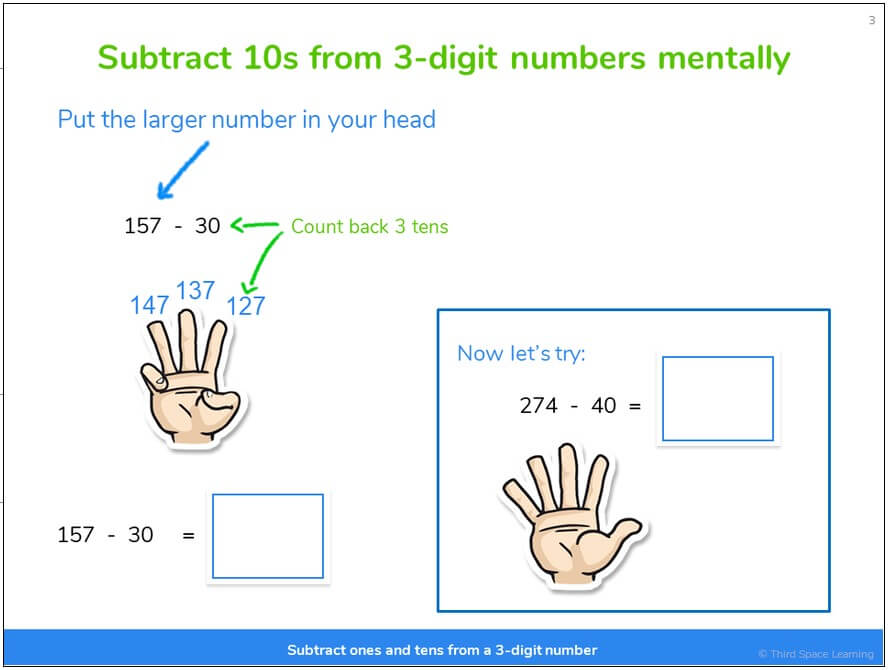
9. Place value two digit number game: in the bucket
In year 2, children are expected to identify and recognise each digit in a 2-digit number. This game is great for helping children to understand place value.
What you will need to play:
- 2 or more players.
- 2 boxes or buckets
- Bean bags.
- A selection of 2-digit number cards from 10 to 99
How to play:
- Player one takes a 2-digit number card
- The aim of the game is to use bean bags to make that 2-digit number.
- The 2 boxes/buckets represent the tens and the ones. Children need to try and get the correct number of beanbags into each box, to represent the tens and the ones.
- If the card selected has 54 on it, the player needs to attempt to get 5 bean bags in the ‘tens’ box and 4 bean bags in the ‘ones’ box.
- Players score a point if they get the bean bags into the correct boxes.
- This game can also be played as a relay race with 2 teams competing against each other.
This video shows an example of how this game can be played at KS2 for numbers greater than two digits. Please note that for KS1 this game would only require 2 buckets as you would only be working with 2-digit numbers.
10. Addition maths game: skunk
This is another great KS1 maths game for practising addition skills, whilst getting children to think about the best strategy.
What you will need to play:
- 2 players
- 2 dice
- Paper and pen
How to play:
- Write the word skunk and separate each letter into a different column on a sheet of paper. Each letter of the word ‘skunk’ represents a different round of the game.
- The first player rolls a pair of dice and works out the total of the two dice. The score is written in the S column. If they roll a one they score zero.
- Once they have their first score under the letter ‘S’, they have to make the decision to either stop and take that score as their score for the game, or roll again and hope they score even more to add to the first round score.
- If they roll a one in the second round, play stops and the player takes the score from the first round as their total for the game. The risk a player takes in moving on and throwing again, is if two ones are thrown, all the points for the game are wiped and the player scores zero.
- The winner is the player with the most points at the end of the game.
11. Addition maths game: make 20
This KS1 maths game is great for practising addition of numbers up to 20. The speed element helps children work on their fluency.
What you will need to play:
- One or more players
- Post it notes with the numbers 0-20
- A large circle (this can be a hoop or a circle draw on paper)
How to play:
- Put the circle in the middle and place the post-its around the outside.
- This is a speed game in which players need to match the pairs of post-it notes which equal 20 and stick them in the circle.
- Time the player to see how quickly they can make all the pairs. This is then either the target time for the other player, or their own target time, if they are playing alone.
12. Maths fluency game: maths fact top it
This is another good KS1 maths game for building fluency of addition and subtraction facts.
What you will need to play:
- 2 or more players
- A set of maths fact flash cards which you can create yourself based on children’s prior knowledge of addition or subtraction up to 20 Eg. 7 + 5, 9 + 6, 2 + 11
How to play:
- Players divide up all the maths fact cards and hold in their hands. On the count of 3, each player throws down one card.
- The card with the highest total wins all the cards. If 2 players have the same answer, they play each other again.
- The winner is last player left in, once all the others have lost all their cards.
13. Addition and subtraction game: guess my number
In this game, children use information available to them to work out their mystery number. This is a fun way to practise missing number addition and subtraction.
What you will need to play:
- 3 players – 2 playing and 1 leading
- A set of 1-10 digit cards
How to play:
- Lay the 10 cards face down on the table.
- Each player selects a card and without looking at it, holds it to their forehead, so the other player can see it.
- The child chosen to lead the game calls out a statement about the 2 cards, such as ‘the 2 numbers added together equal…’
- Each child has to look at their partner’s card to work out what their own number must be.
- The winner is the first one to call out the correct number.
14. Shapes game: what shape am I?
In year 2, children learn to identify and describe the properties of 2D shapes and 3D shapes. This game is good for practising this and can be played as either a 2D or a 3D shape game.
What you will need to play?
- 2 or more players.
- Pictures of 2D or 3D shapes for children who need them.
How to play:
- Each player chooses a shape and writes 5 statements about their shape.
- The aim of the game is to be the person who asks the least number of questions to work out the other player’s shape.
- Players need to make their first statements vague, to encourage the other player to ask more questions. E.g. ‘My shape is 2D’, ‘my shape has 3 sides’, ‘my shape has 6 faces’ etc..
- After a player receives a statement on the mystery shape, they can choose to make a guess, or ask for another statement. If they guess correctly after the first statement, they get the full 5 points. If they guess after two statements, they get 4 points, and so on…
- If they make a guess and it is incorrect, they receive 0 points for that round.
- The aim of the game is to be the player with the most points at the end of the game.
15. Maths dice game: ten sided dice rounding game
This simple Ks1 maths game helps children to understand the concept of rounding up and down.
What you will need to play:
- 2 players
- A 10-sided dice
How to play:
- Players take it in turns to throw the 10-sided dice.
- One player has the rounding down numbers 1, 2, 3, 4 and 10 (which represents 0). The other player has the round up numbers 5, 6, 7, 8 and 9.
- Take it in turns to throw the dice. If it lands on one of the rounding down numbers, that player scores a point. If it lands on one of the rounding up numbers, the other player scores a point.
16. Maths fractions game: snap
In year 2, children learn to recognise the fractions 1/3, 1/4, 1/2, 2/4 and 3/4. This game is a fun way of practising this.
What you will need to play:
- 2 players
- A set of fraction cards (see downloadable resource pack)
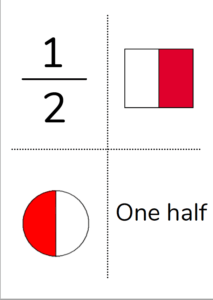
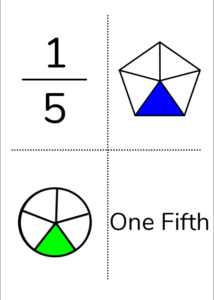
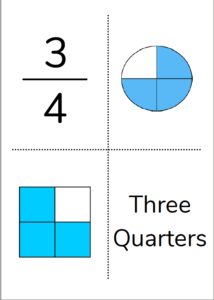
How to play:
- Shuffle the cards and share out between the 2 players.
- Each player places their pile of cards face down on the table.
- Players take it in turns to turn over a card. If 2 consecutive cards have a matching fraction and picture, the first player to put their hand on the pile and shout ‘snap’ wins all the cards.
- Players then begin again. The winner is the last person to lose all their cards.
More useful year 2 resources: Year 2 Curriculum Toolkit
Mental maths games KS1
Mental maths games are great for building fluency. Many of these games need minimal or no resources and are quick and easy to set up. They can be played at any point during the maths lesson, or as a filler activity at any point in the school day.
17. Addition war
By the end of KS1, children should be able to use and recall addition and subtraction facts to 20. This game is a fun way of practising this skill, with the speed element enabling children to work on fluency.
What you will need to play:
- 2 players
- A set of playing cards with the picture cards removed (Ace is worth 1)
How to play:
- Share between the 2 players, so they make 2 piles, face down on the table.
- At the same time, both players turn over a card from their pile and place it in the middle of the table.
- The aim of the game is to add both numbers together and be the first to call out the answer.
- The first person to call out the correct answer gets to keep the cards.
- The winner at the end of the game, is the person who has collected the most cards.
18. Times tables game bang bang
This is a fun KS1 maths game for practising times tables (in this case the 5 times table). It can be adapted to suit other times tables or mental maths skills, such as addition and subtraction of numbers to 20 or number bonds to 10 or to 20.
What you will need to play:
- 2 players at a time, but a whole class game.
How to play:
- 2 players stand at the front of the classroom back to back, cowboy shootout style.
- The teacher, or the game leader calls out a number. Players have to work out how many groups of 5 are needed to make that number. For example, if the teacher calls out ‘40’, the players need to call out 8 as there are 8 groups of 5s in 40; 8 x 5 = 40
- The first player to turn, face their opponent, shout ‘bang bang’ and give the answer wins the round.
- Another member of the class then comes out to the front as ‘the challenger’.
- The winner is the last person standing once time runs out.
19. Maths, paper, scissors
This is a KS1 maths game that requires no set-up and is great for building fluency with addition and subtraction facts.
What you will need to play:
- 2 players
How to play:
- Both players stand facing each other.
- Similar to the traditional game of ‘paper, scissors, stone’, players hold one hand out in front but this time call out ‘maths, paper, scissors’. On ‘scissors’, they hold out any number of fingers.
- Players then have to race to add together the number of fingers they are holding out to the number of fingers the other player is holding out.
- The winner is the first player to call out the total.
- This can be adapted by having both children using 2 hands, to make larger numbers.
- The game can also be played as a subtraction game, subtracting the smallest from the biggest number.
20. The yes / no mental maths game
This is another quick and easy KS1 maths game to set up and can again be played at any time, when there’s a spare few minutes.
What you need to play:
- 2 or more players.
How to play:
- One player thinks of a number between 0 and 20.
- The aim for the other player (or the rest of the class, if playing as a whole class) is to ask questions to work out the number.
- The questions can only have the answer ‘yes’ or ‘no’.
- For example, the number could be ‘16’. Children can ask questions such as, ‘is it an even number?’, ‘is it greater than 10?’ ‘Is it less than 18?’
- The winner is the player to have worked out the mystery number with the fewest number of questions asked.
21. Number bond bingo
This is another fun KS1 mental maths game which gets children practising number bonds to 10 and to 20. It is a good game for playing as a whole class.
What you need to play:
- 3 or more players (can be played as a whole class)
- A piece of paper and pen for each player
How to play:
- Choose one person to be the leader of the game. In a whole class situation, this could be the teacher.
- Children write down 5 numbers (under 10 if practising number bonds to 10, or under 20 if pracising number bonds to 20)
- The leader of the game then calls out numbers (under 10 or under 20).
- If a number is called out and players have the number which will make it a number bond to 10 or to 20, they cross out that number. E.g: If the teacher calls out ‘7’ and player with the number ‘3’ on their board can cross it out, or ‘13’ if they are playing number bonds to 20.
- The winner is the first person to cross out all their numbers and shout ‘bingo’
22. Target 50
This is another KS1 mental maths game which is quick and easy to set up and great for practising addition fact fluency.
What you need to play:
- 2 or more players (can be played as a whole class)
- A dice
- Pen and paper
How to play:
- Split the class into 2 teams
- The teacher rolls the dice (this can be a digital dice online) and team 1 adds up the numbers thrown. The teacher continues rolling until either a ‘1’ is thrown or until the teams tells them to ‘bank’ the total so far.
- The first team to reach 50 is the winning team.
More mental maths resources
Problem solving games KS1
Problem solving games are a great way for children to deepen their mathematical understanding. These games require children to think strategically and to approach problems in different ways.
23. Addition turnover
This KS1 maths game is great for developing addition skills, whilst encouraging children to think strategically.
What you need to play:
- 1 or 2 players
- A pack of cards (2 – 10 cards only)
- 2 dice
How to play:
- This game can be played individually or against a partner.
- Shuffle the cards and lay 18 cards out in front, at 3 rows of 6.
- Throw 2 dice and add the numbers together.
- Turn over the playing cards to match the total on the dice. For example, if a 5 and 4 are thrown, the player needs to turn over cards which total 9. This could be 1 or more cards.
- The other player then does the same.
- The aim of the game is to be the player with the most cards once all the cards have been cleared.
- Players need to think tactically when playing, using the combination of cards which enables them to remove the most cards in one go.
24. Number 4 in a row
This KS1 problem solving game enables children to practise their addition and subtraction skills and encourages them to think tactically, not only about their own counters but also about those of their partner’s
What you need to play:
- 2 players
- A 6 by 6 grid containing the numbers 2 to 12 (see downloadable resource pack)
- 2 dice
- Counters
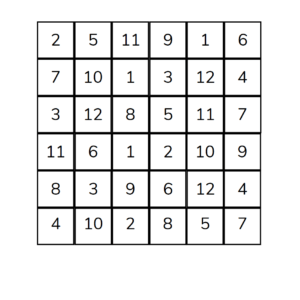
How to play:
- The first player throws the 2 dice and adds the 2 numbers together. They then place a counter or colour in a square containing that number.
- The 2nd player does the same, placing a different coloured counter on the grid, or colouring in with a different colour.
- The aim of the game is to be the first player to cover 4 squares in a row (horizontally, vertically or diagonally).
- Children aren’t only thinking about how to make a line of 4 themselves. They also need to think about blocking the other player from making a row of 4.
Looking for more fun games to boost pupils’ learning? Look out for our top 25 maths games you can do at home, 26 KS2 maths games as well as our favourite times tables games and place value games.
Hopefully this blog has given you some ideas for games you could play in your classroom. Most are easy to adapt, to suit any age or the topic you are covering. Don’t just adapt the maths games yourself. Give children the opportunity to adapt and think up their own rules too.
Download your free KS1 Maths Games Printable Resource Pack here!
If you want to engage children more fully with maths, Third Space Learning’s online maths lessons provide one to one support that’s personalised to children’s needs. Tutors make lessons fun, and match the interests and previous maths experience of the child being taught.
DO YOU HAVE STUDENTS WHO NEED MORE SUPPORT IN MATHS?
Skye – our AI maths tutor built by teachers – gives students personalised one-to-one lessons that address learning gaps and build confidence.
Since 2013 we’ve taught over 2 million hours of maths lessons to more than 170,000 students to help them become fluent, able mathematicians.
Explore our AI maths tutoring or find out about school tutors for your school.
